Organisational Behaviour at Tesco: Culture, Motivation & Teams
VerifiedAdded on 2024/05/17
|26
|5483
|279
Report
AI Summary
This report provides a comprehensive analysis of organisational behaviour, focusing on how an organization's culture, politics, and power influence individual and team behavior and performance. It evaluates content and process theories of motivation and motivational techniques, examining their role in achieving organizational goals. The report also explores the characteristics of effective versus ineffective teams and analyzes relevant team development theories to foster dynamic cooperation. Furthermore, it applies concepts and philosophies of organizational behavior within an organizational context, specifically referencing Tesco, and evaluates how these concepts influence behavior in both positive and negative ways. The analysis draws upon various models and theories, including Handy's model of organizational culture, French and Raven's five bases of power, Maslow's hierarchy of needs, Herzberg's two-factor theory, and various process theories, to provide a detailed understanding of organizational dynamics.

ORGANISATIONAL BEHAVIOR
Paraphrase This Document
Need a fresh take? Get an instant paraphrase of this document with our AI Paraphraser
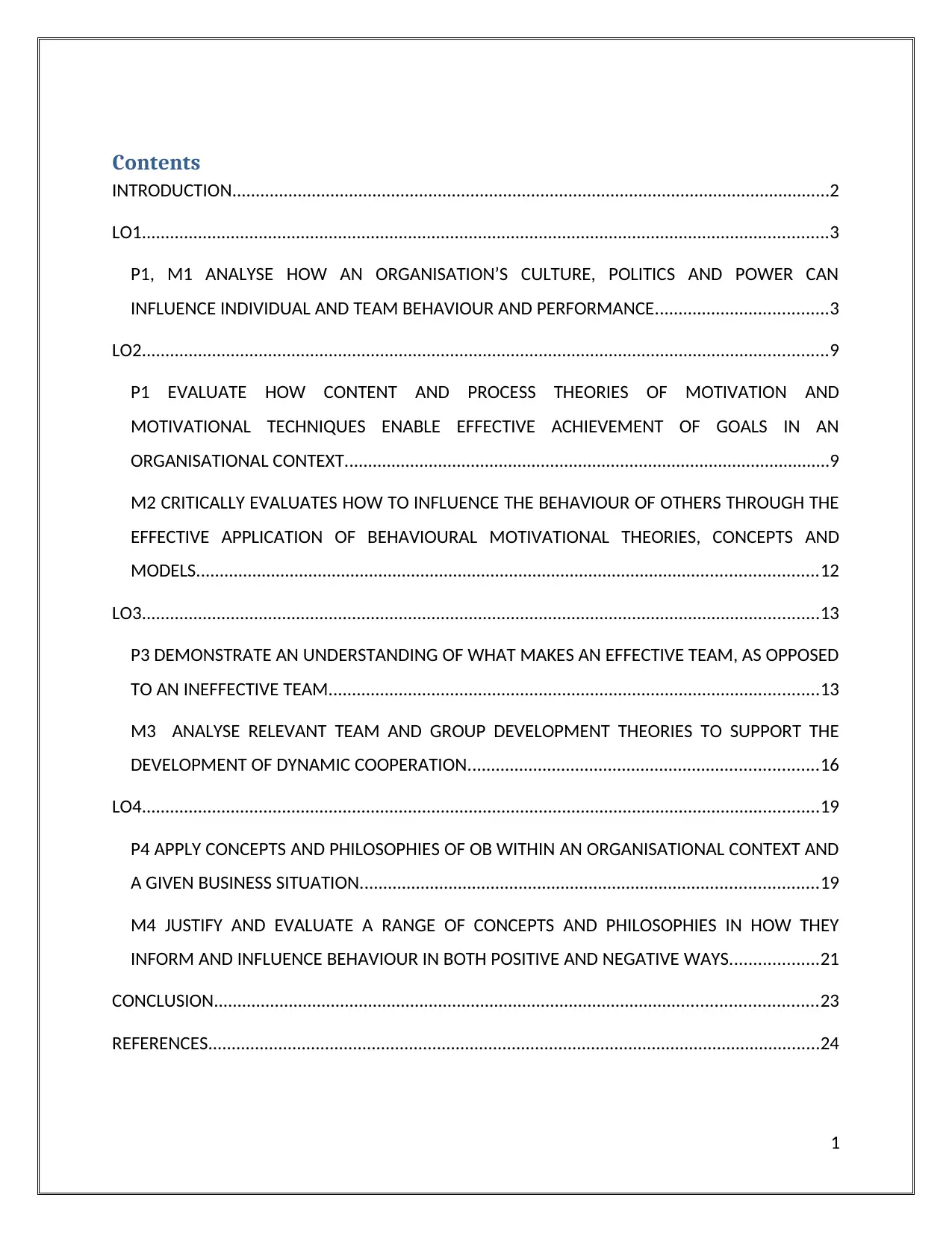
Contents
INTRODUCTION................................................................................................................................2
LO1...................................................................................................................................................3
P1, M1 ANALYSE HOW AN ORGANISATION’S CULTURE, POLITICS AND POWER CAN
INFLUENCE INDIVIDUAL AND TEAM BEHAVIOUR AND PERFORMANCE.....................................3
LO2...................................................................................................................................................9
P1 EVALUATE HOW CONTENT AND PROCESS THEORIES OF MOTIVATION AND
MOTIVATIONAL TECHNIQUES ENABLE EFFECTIVE ACHIEVEMENT OF GOALS IN AN
ORGANISATIONAL CONTEXT........................................................................................................9
M2 CRITICALLY EVALUATES HOW TO INFLUENCE THE BEHAVIOUR OF OTHERS THROUGH THE
EFFECTIVE APPLICATION OF BEHAVIOURAL MOTIVATIONAL THEORIES, CONCEPTS AND
MODELS.....................................................................................................................................12
LO3.................................................................................................................................................13
P3 DEMONSTRATE AN UNDERSTANDING OF WHAT MAKES AN EFFECTIVE TEAM, AS OPPOSED
TO AN INEFFECTIVE TEAM.........................................................................................................13
M3 ANALYSE RELEVANT TEAM AND GROUP DEVELOPMENT THEORIES TO SUPPORT THE
DEVELOPMENT OF DYNAMIC COOPERATION...........................................................................16
LO4.................................................................................................................................................19
P4 APPLY CONCEPTS AND PHILOSOPHIES OF OB WITHIN AN ORGANISATIONAL CONTEXT AND
A GIVEN BUSINESS SITUATION..................................................................................................19
M4 JUSTIFY AND EVALUATE A RANGE OF CONCEPTS AND PHILOSOPHIES IN HOW THEY
INFORM AND INFLUENCE BEHAVIOUR IN BOTH POSITIVE AND NEGATIVE WAYS...................21
CONCLUSION.................................................................................................................................23
REFERENCES...................................................................................................................................24
1
INTRODUCTION................................................................................................................................2
LO1...................................................................................................................................................3
P1, M1 ANALYSE HOW AN ORGANISATION’S CULTURE, POLITICS AND POWER CAN
INFLUENCE INDIVIDUAL AND TEAM BEHAVIOUR AND PERFORMANCE.....................................3
LO2...................................................................................................................................................9
P1 EVALUATE HOW CONTENT AND PROCESS THEORIES OF MOTIVATION AND
MOTIVATIONAL TECHNIQUES ENABLE EFFECTIVE ACHIEVEMENT OF GOALS IN AN
ORGANISATIONAL CONTEXT........................................................................................................9
M2 CRITICALLY EVALUATES HOW TO INFLUENCE THE BEHAVIOUR OF OTHERS THROUGH THE
EFFECTIVE APPLICATION OF BEHAVIOURAL MOTIVATIONAL THEORIES, CONCEPTS AND
MODELS.....................................................................................................................................12
LO3.................................................................................................................................................13
P3 DEMONSTRATE AN UNDERSTANDING OF WHAT MAKES AN EFFECTIVE TEAM, AS OPPOSED
TO AN INEFFECTIVE TEAM.........................................................................................................13
M3 ANALYSE RELEVANT TEAM AND GROUP DEVELOPMENT THEORIES TO SUPPORT THE
DEVELOPMENT OF DYNAMIC COOPERATION...........................................................................16
LO4.................................................................................................................................................19
P4 APPLY CONCEPTS AND PHILOSOPHIES OF OB WITHIN AN ORGANISATIONAL CONTEXT AND
A GIVEN BUSINESS SITUATION..................................................................................................19
M4 JUSTIFY AND EVALUATE A RANGE OF CONCEPTS AND PHILOSOPHIES IN HOW THEY
INFORM AND INFLUENCE BEHAVIOUR IN BOTH POSITIVE AND NEGATIVE WAYS...................21
CONCLUSION.................................................................................................................................23
REFERENCES...................................................................................................................................24
1
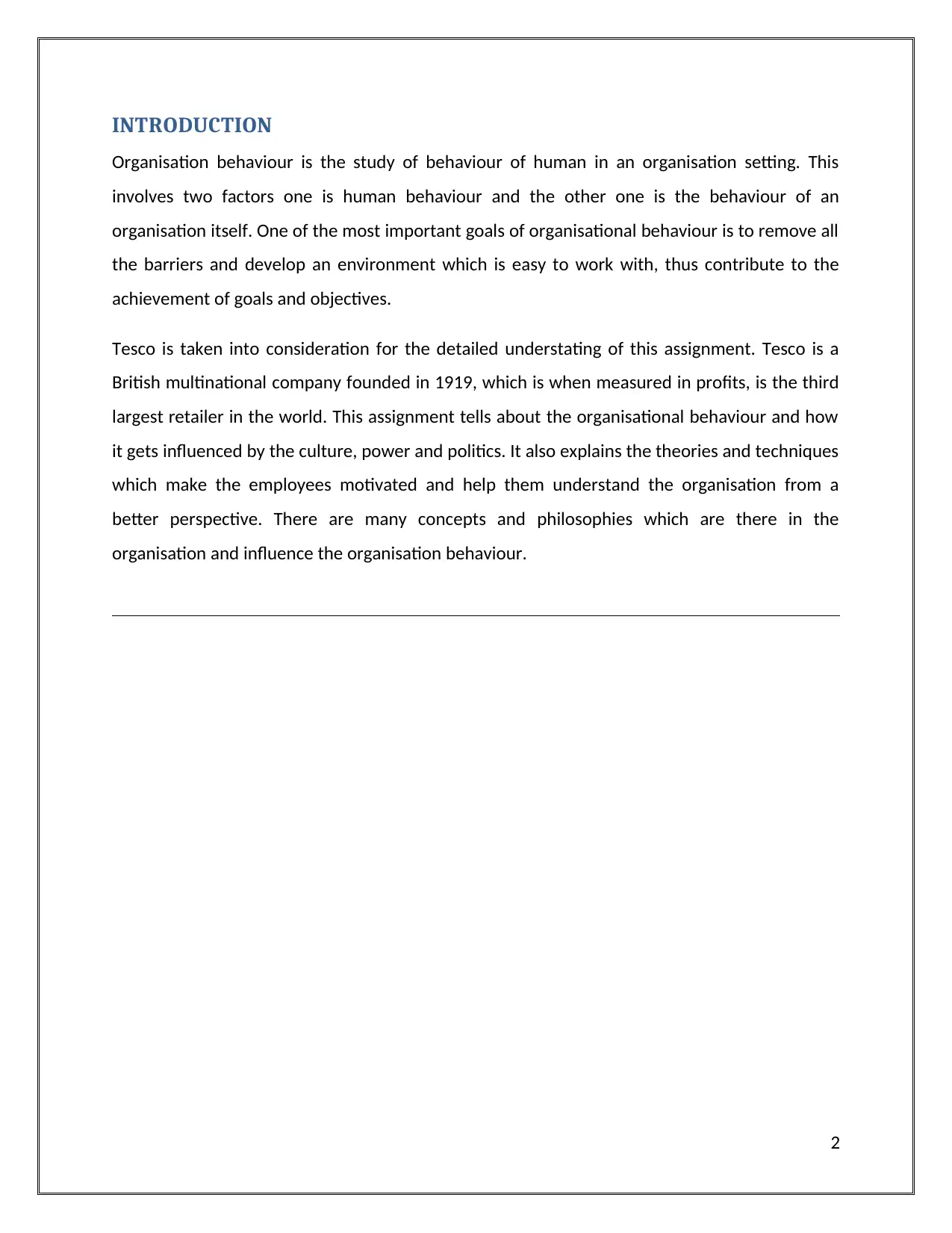
INTRODUCTION
Organisation behaviour is the study of behaviour of human in an organisation setting. This
involves two factors one is human behaviour and the other one is the behaviour of an
organisation itself. One of the most important goals of organisational behaviour is to remove all
the barriers and develop an environment which is easy to work with, thus contribute to the
achievement of goals and objectives.
Tesco is taken into consideration for the detailed understating of this assignment. Tesco is a
British multinational company founded in 1919, which is when measured in profits, is the third
largest retailer in the world. This assignment tells about the organisational behaviour and how
it gets influenced by the culture, power and politics. It also explains the theories and techniques
which make the employees motivated and help them understand the organisation from a
better perspective. There are many concepts and philosophies which are there in the
organisation and influence the organisation behaviour.
2
Organisation behaviour is the study of behaviour of human in an organisation setting. This
involves two factors one is human behaviour and the other one is the behaviour of an
organisation itself. One of the most important goals of organisational behaviour is to remove all
the barriers and develop an environment which is easy to work with, thus contribute to the
achievement of goals and objectives.
Tesco is taken into consideration for the detailed understating of this assignment. Tesco is a
British multinational company founded in 1919, which is when measured in profits, is the third
largest retailer in the world. This assignment tells about the organisational behaviour and how
it gets influenced by the culture, power and politics. It also explains the theories and techniques
which make the employees motivated and help them understand the organisation from a
better perspective. There are many concepts and philosophies which are there in the
organisation and influence the organisation behaviour.
2
⊘ This is a preview!⊘
Do you want full access?
Subscribe today to unlock all pages.

Trusted by 1+ million students worldwide
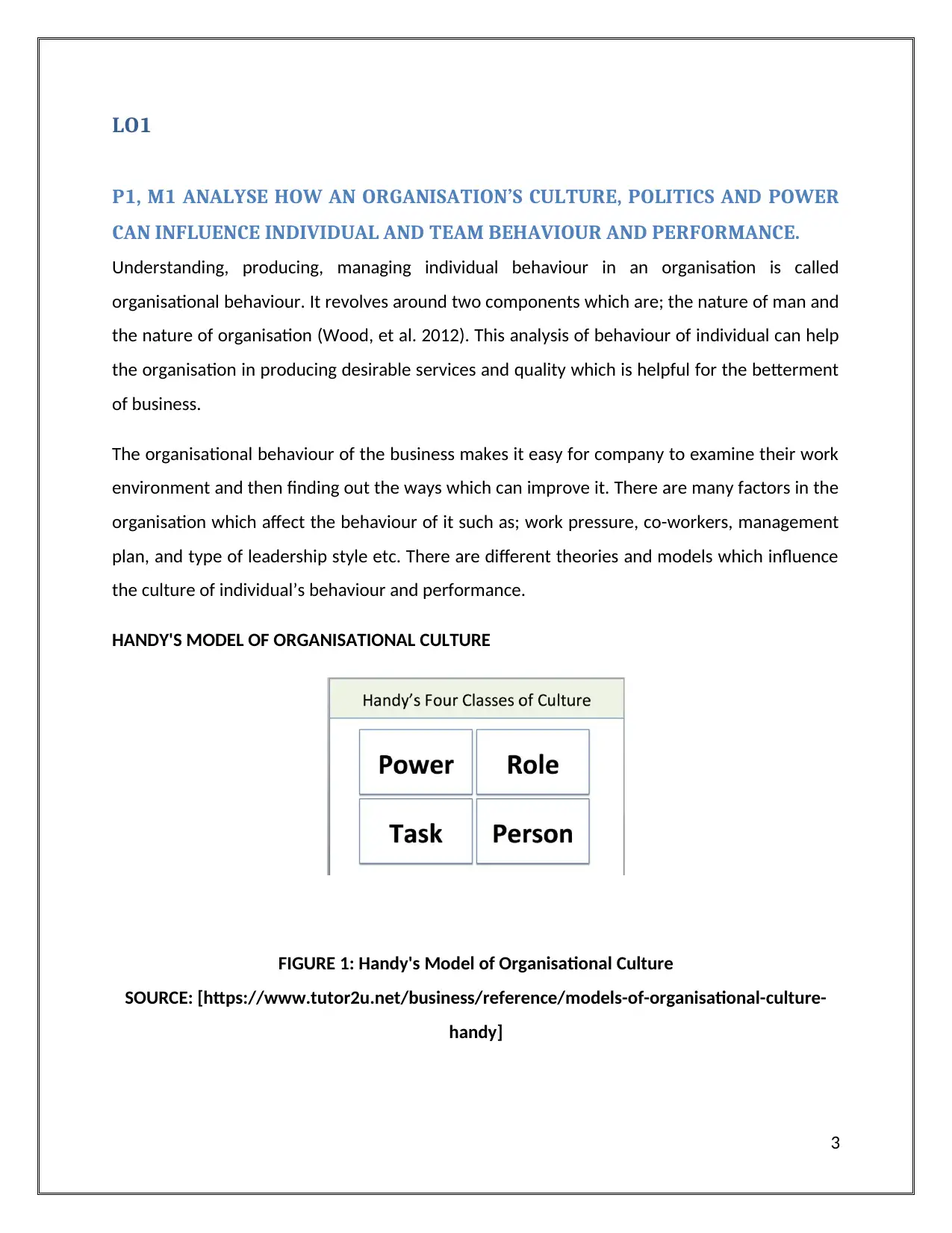
LO1
P1, M1 ANALYSE HOW AN ORGANISATION’S CULTURE, POLITICS AND POWER
CAN INFLUENCE INDIVIDUAL AND TEAM BEHAVIOUR AND PERFORMANCE.
Understanding, producing, managing individual behaviour in an organisation is called
organisational behaviour. It revolves around two components which are; the nature of man and
the nature of organisation (Wood, et al. 2012). This analysis of behaviour of individual can help
the organisation in producing desirable services and quality which is helpful for the betterment
of business.
The organisational behaviour of the business makes it easy for company to examine their work
environment and then finding out the ways which can improve it. There are many factors in the
organisation which affect the behaviour of it such as; work pressure, co-workers, management
plan, and type of leadership style etc. There are different theories and models which influence
the culture of individual’s behaviour and performance.
HANDY'S MODEL OF ORGANISATIONAL CULTURE
FIGURE 1: Handy's Model of Organisational Culture
SOURCE: [https://www.tutor2u.net/business/reference/models-of-organisational-culture-
handy]
3
P1, M1 ANALYSE HOW AN ORGANISATION’S CULTURE, POLITICS AND POWER
CAN INFLUENCE INDIVIDUAL AND TEAM BEHAVIOUR AND PERFORMANCE.
Understanding, producing, managing individual behaviour in an organisation is called
organisational behaviour. It revolves around two components which are; the nature of man and
the nature of organisation (Wood, et al. 2012). This analysis of behaviour of individual can help
the organisation in producing desirable services and quality which is helpful for the betterment
of business.
The organisational behaviour of the business makes it easy for company to examine their work
environment and then finding out the ways which can improve it. There are many factors in the
organisation which affect the behaviour of it such as; work pressure, co-workers, management
plan, and type of leadership style etc. There are different theories and models which influence
the culture of individual’s behaviour and performance.
HANDY'S MODEL OF ORGANISATIONAL CULTURE
FIGURE 1: Handy's Model of Organisational Culture
SOURCE: [https://www.tutor2u.net/business/reference/models-of-organisational-culture-
handy]
3
Paraphrase This Document
Need a fresh take? Get an instant paraphrase of this document with our AI Paraphraser
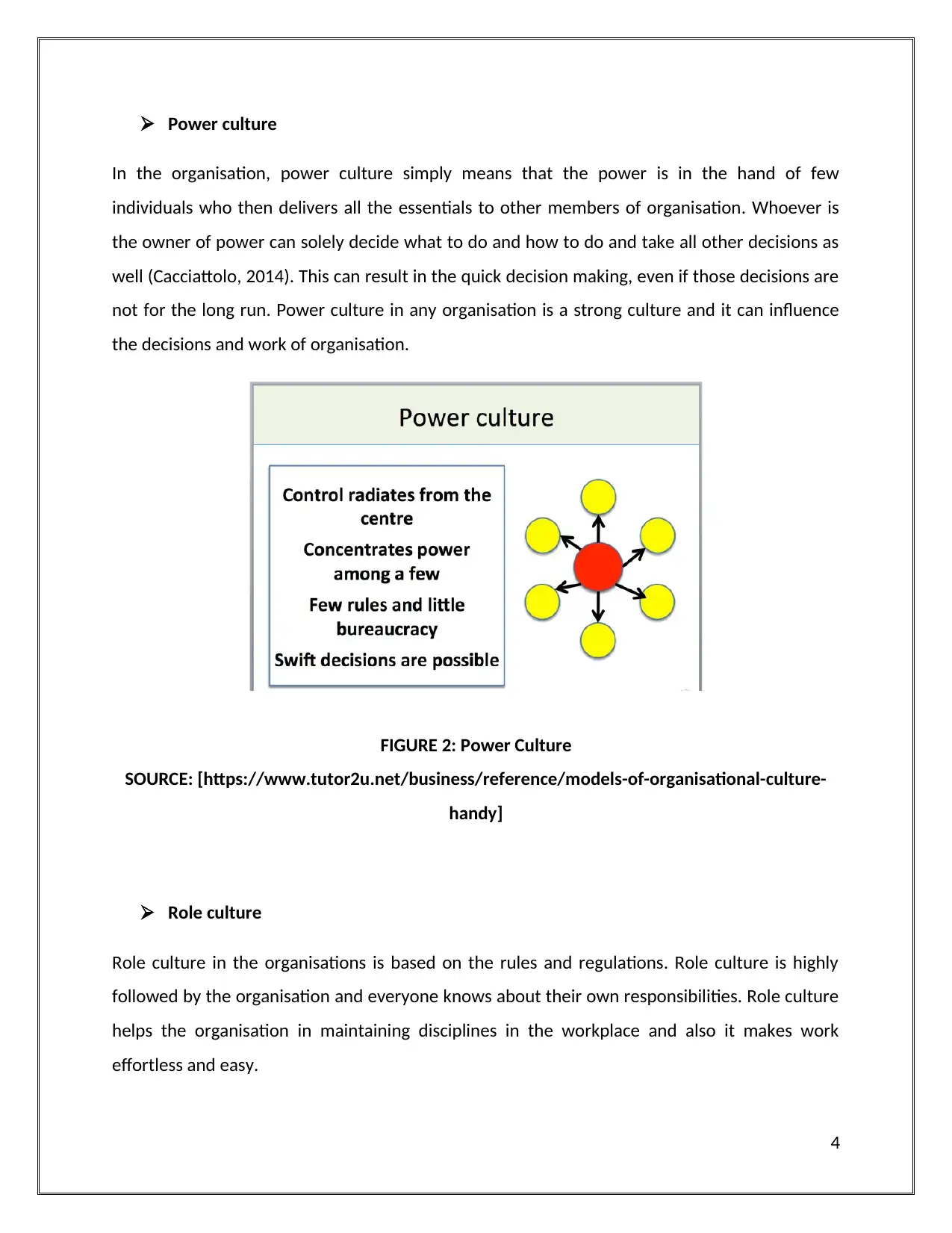
Power culture
In the organisation, power culture simply means that the power is in the hand of few
individuals who then delivers all the essentials to other members of organisation. Whoever is
the owner of power can solely decide what to do and how to do and take all other decisions as
well (Cacciattolo, 2014). This can result in the quick decision making, even if those decisions are
not for the long run. Power culture in any organisation is a strong culture and it can influence
the decisions and work of organisation.
FIGURE 2: Power Culture
SOURCE: [https://www.tutor2u.net/business/reference/models-of-organisational-culture-
handy]
Role culture
Role culture in the organisations is based on the rules and regulations. Role culture is highly
followed by the organisation and everyone knows about their own responsibilities. Role culture
helps the organisation in maintaining disciplines in the workplace and also it makes work
effortless and easy.
4
In the organisation, power culture simply means that the power is in the hand of few
individuals who then delivers all the essentials to other members of organisation. Whoever is
the owner of power can solely decide what to do and how to do and take all other decisions as
well (Cacciattolo, 2014). This can result in the quick decision making, even if those decisions are
not for the long run. Power culture in any organisation is a strong culture and it can influence
the decisions and work of organisation.
FIGURE 2: Power Culture
SOURCE: [https://www.tutor2u.net/business/reference/models-of-organisational-culture-
handy]
Role culture
Role culture in the organisations is based on the rules and regulations. Role culture is highly
followed by the organisation and everyone knows about their own responsibilities. Role culture
helps the organisation in maintaining disciplines in the workplace and also it makes work
effortless and easy.
4
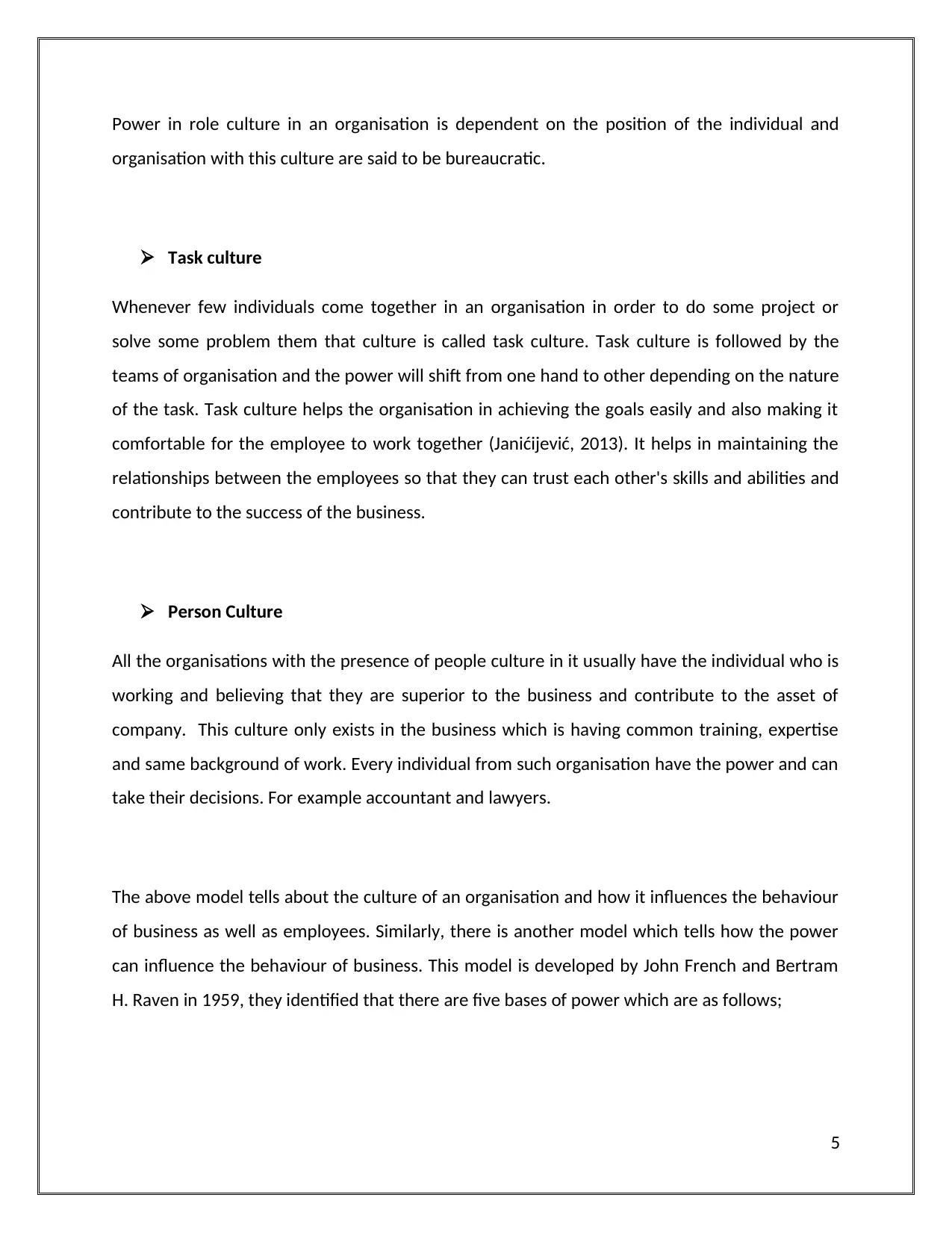
Power in role culture in an organisation is dependent on the position of the individual and
organisation with this culture are said to be bureaucratic.
Task culture
Whenever few individuals come together in an organisation in order to do some project or
solve some problem them that culture is called task culture. Task culture is followed by the
teams of organisation and the power will shift from one hand to other depending on the nature
of the task. Task culture helps the organisation in achieving the goals easily and also making it
comfortable for the employee to work together (Janićijević, 2013). It helps in maintaining the
relationships between the employees so that they can trust each other's skills and abilities and
contribute to the success of the business.
Person Culture
All the organisations with the presence of people culture in it usually have the individual who is
working and believing that they are superior to the business and contribute to the asset of
company. This culture only exists in the business which is having common training, expertise
and same background of work. Every individual from such organisation have the power and can
take their decisions. For example accountant and lawyers.
The above model tells about the culture of an organisation and how it influences the behaviour
of business as well as employees. Similarly, there is another model which tells how the power
can influence the behaviour of business. This model is developed by John French and Bertram
H. Raven in 1959, they identified that there are five bases of power which are as follows;
5
organisation with this culture are said to be bureaucratic.
Task culture
Whenever few individuals come together in an organisation in order to do some project or
solve some problem them that culture is called task culture. Task culture is followed by the
teams of organisation and the power will shift from one hand to other depending on the nature
of the task. Task culture helps the organisation in achieving the goals easily and also making it
comfortable for the employee to work together (Janićijević, 2013). It helps in maintaining the
relationships between the employees so that they can trust each other's skills and abilities and
contribute to the success of the business.
Person Culture
All the organisations with the presence of people culture in it usually have the individual who is
working and believing that they are superior to the business and contribute to the asset of
company. This culture only exists in the business which is having common training, expertise
and same background of work. Every individual from such organisation have the power and can
take their decisions. For example accountant and lawyers.
The above model tells about the culture of an organisation and how it influences the behaviour
of business as well as employees. Similarly, there is another model which tells how the power
can influence the behaviour of business. This model is developed by John French and Bertram
H. Raven in 1959, they identified that there are five bases of power which are as follows;
5
⊘ This is a preview!⊘
Do you want full access?
Subscribe today to unlock all pages.

Trusted by 1+ million students worldwide
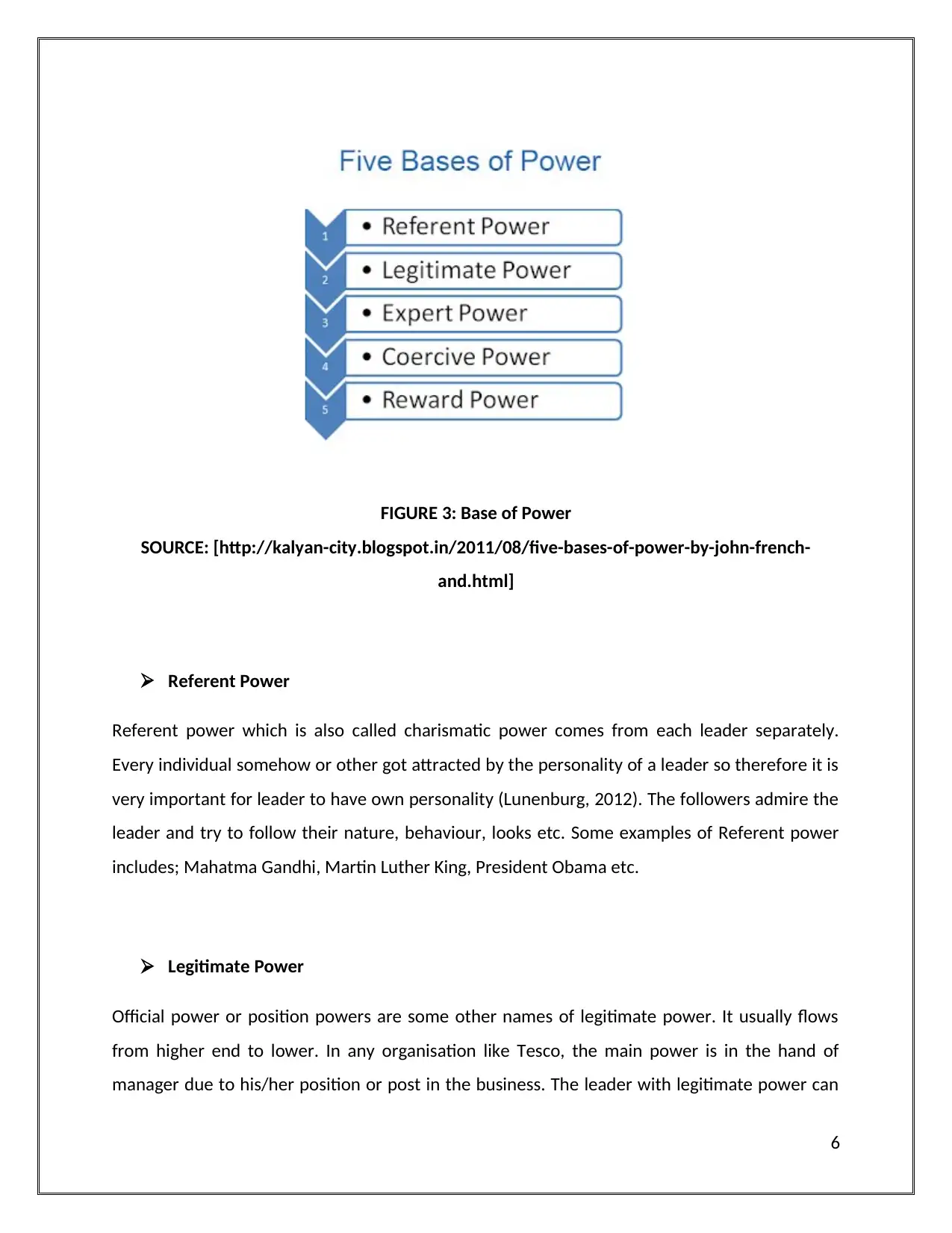
FIGURE 3: Base of Power
SOURCE: [http://kalyan-city.blogspot.in/2011/08/five-bases-of-power-by-john-french-
and.html]
Referent Power
Referent power which is also called charismatic power comes from each leader separately.
Every individual somehow or other got attracted by the personality of a leader so therefore it is
very important for leader to have own personality (Lunenburg, 2012). The followers admire the
leader and try to follow their nature, behaviour, looks etc. Some examples of Referent power
includes; Mahatma Gandhi, Martin Luther King, President Obama etc.
Legitimate Power
Official power or position powers are some other names of legitimate power. It usually flows
from higher end to lower. In any organisation like Tesco, the main power is in the hand of
manager due to his/her position or post in the business. The leader with legitimate power can
6
SOURCE: [http://kalyan-city.blogspot.in/2011/08/five-bases-of-power-by-john-french-
and.html]
Referent Power
Referent power which is also called charismatic power comes from each leader separately.
Every individual somehow or other got attracted by the personality of a leader so therefore it is
very important for leader to have own personality (Lunenburg, 2012). The followers admire the
leader and try to follow their nature, behaviour, looks etc. Some examples of Referent power
includes; Mahatma Gandhi, Martin Luther King, President Obama etc.
Legitimate Power
Official power or position powers are some other names of legitimate power. It usually flows
from higher end to lower. In any organisation like Tesco, the main power is in the hand of
manager due to his/her position or post in the business. The leader with legitimate power can
6
Paraphrase This Document
Need a fresh take? Get an instant paraphrase of this document with our AI Paraphraser
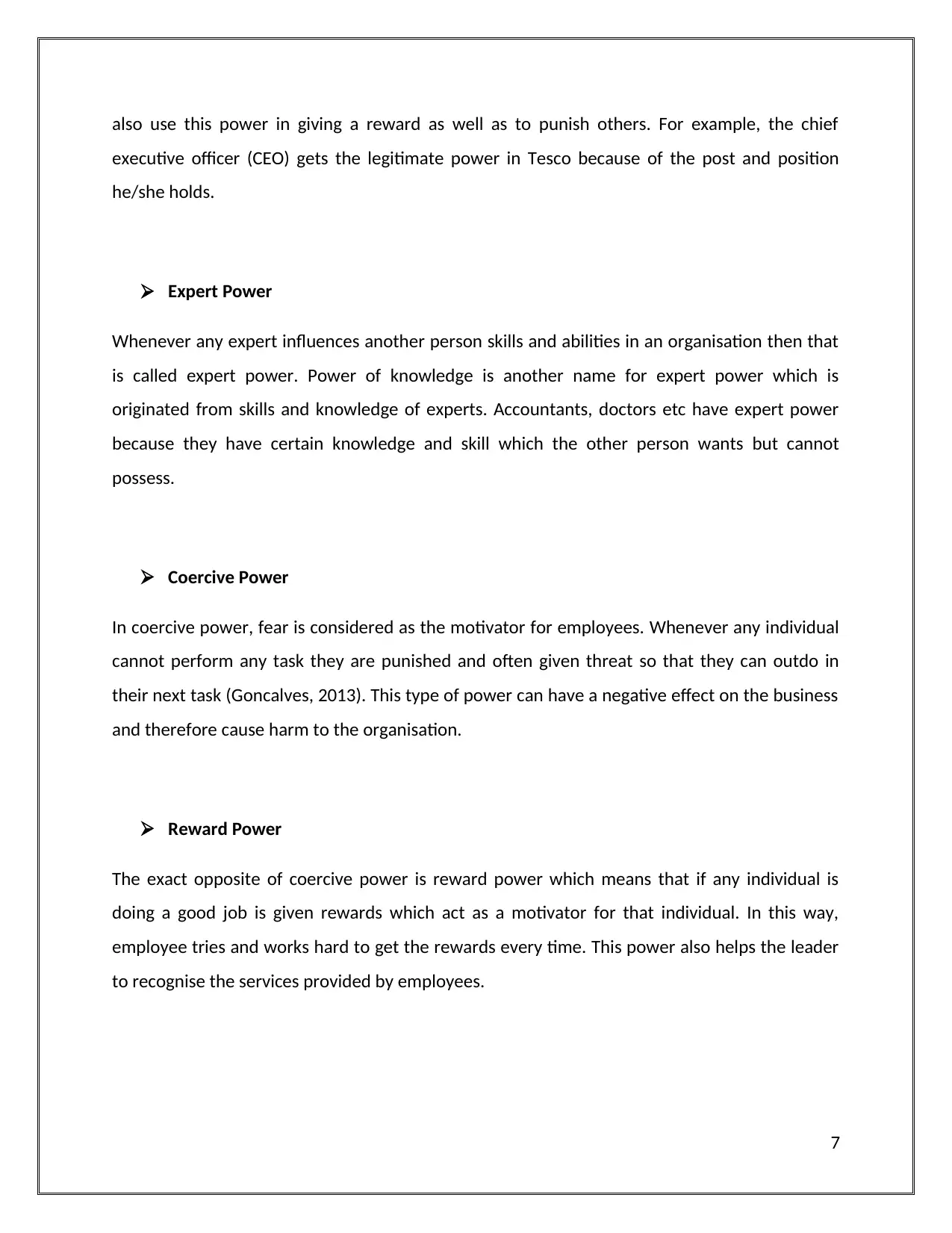
also use this power in giving a reward as well as to punish others. For example, the chief
executive officer (CEO) gets the legitimate power in Tesco because of the post and position
he/she holds.
Expert Power
Whenever any expert influences another person skills and abilities in an organisation then that
is called expert power. Power of knowledge is another name for expert power which is
originated from skills and knowledge of experts. Accountants, doctors etc have expert power
because they have certain knowledge and skill which the other person wants but cannot
possess.
Coercive Power
In coercive power, fear is considered as the motivator for employees. Whenever any individual
cannot perform any task they are punished and often given threat so that they can outdo in
their next task (Goncalves, 2013). This type of power can have a negative effect on the business
and therefore cause harm to the organisation.
Reward Power
The exact opposite of coercive power is reward power which means that if any individual is
doing a good job is given rewards which act as a motivator for that individual. In this way,
employee tries and works hard to get the rewards every time. This power also helps the leader
to recognise the services provided by employees.
7
executive officer (CEO) gets the legitimate power in Tesco because of the post and position
he/she holds.
Expert Power
Whenever any expert influences another person skills and abilities in an organisation then that
is called expert power. Power of knowledge is another name for expert power which is
originated from skills and knowledge of experts. Accountants, doctors etc have expert power
because they have certain knowledge and skill which the other person wants but cannot
possess.
Coercive Power
In coercive power, fear is considered as the motivator for employees. Whenever any individual
cannot perform any task they are punished and often given threat so that they can outdo in
their next task (Goncalves, 2013). This type of power can have a negative effect on the business
and therefore cause harm to the organisation.
Reward Power
The exact opposite of coercive power is reward power which means that if any individual is
doing a good job is given rewards which act as a motivator for that individual. In this way,
employee tries and works hard to get the rewards every time. This power also helps the leader
to recognise the services provided by employees.
7
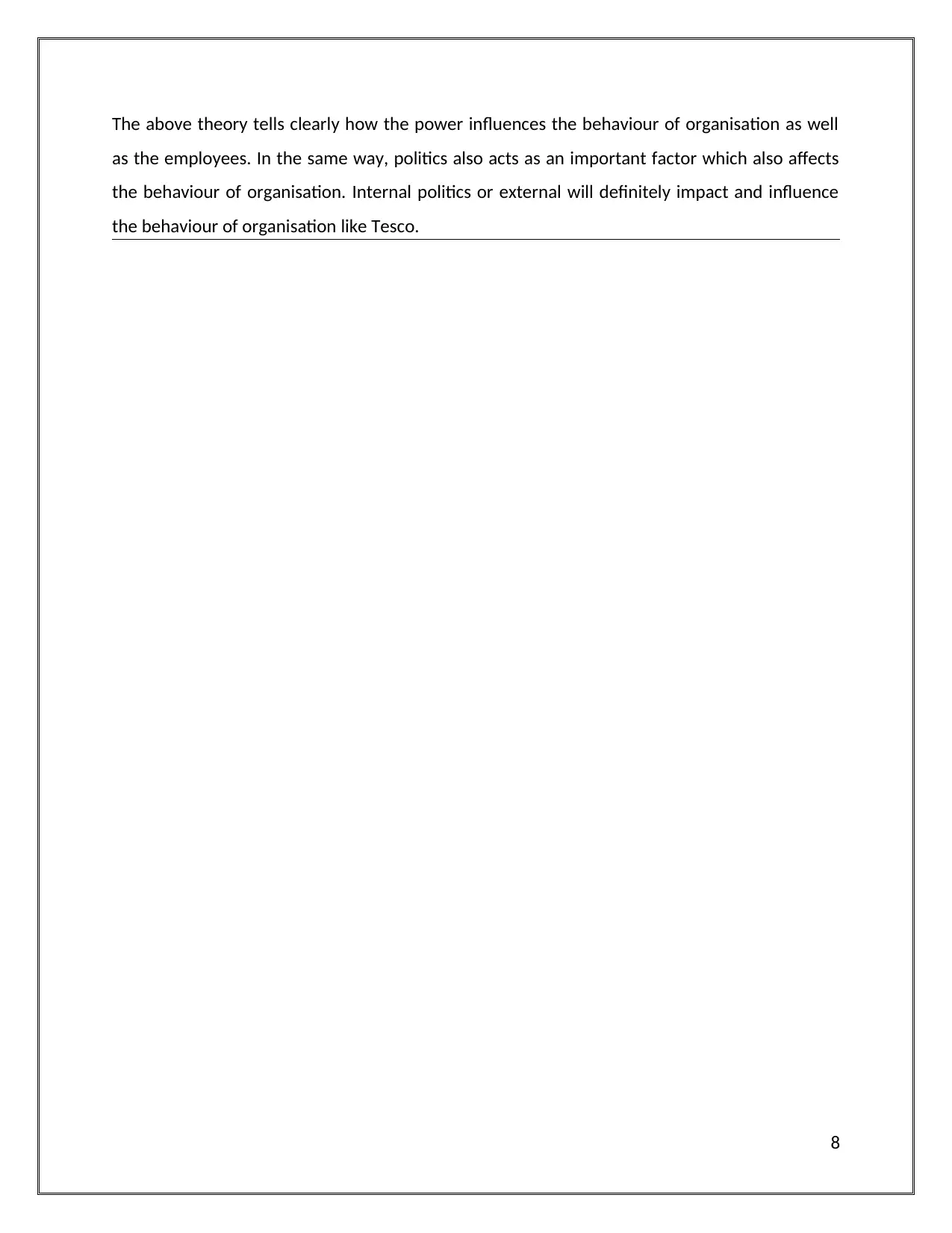
The above theory tells clearly how the power influences the behaviour of organisation as well
as the employees. In the same way, politics also acts as an important factor which also affects
the behaviour of organisation. Internal politics or external will definitely impact and influence
the behaviour of organisation like Tesco.
8
as the employees. In the same way, politics also acts as an important factor which also affects
the behaviour of organisation. Internal politics or external will definitely impact and influence
the behaviour of organisation like Tesco.
8
⊘ This is a preview!⊘
Do you want full access?
Subscribe today to unlock all pages.

Trusted by 1+ million students worldwide
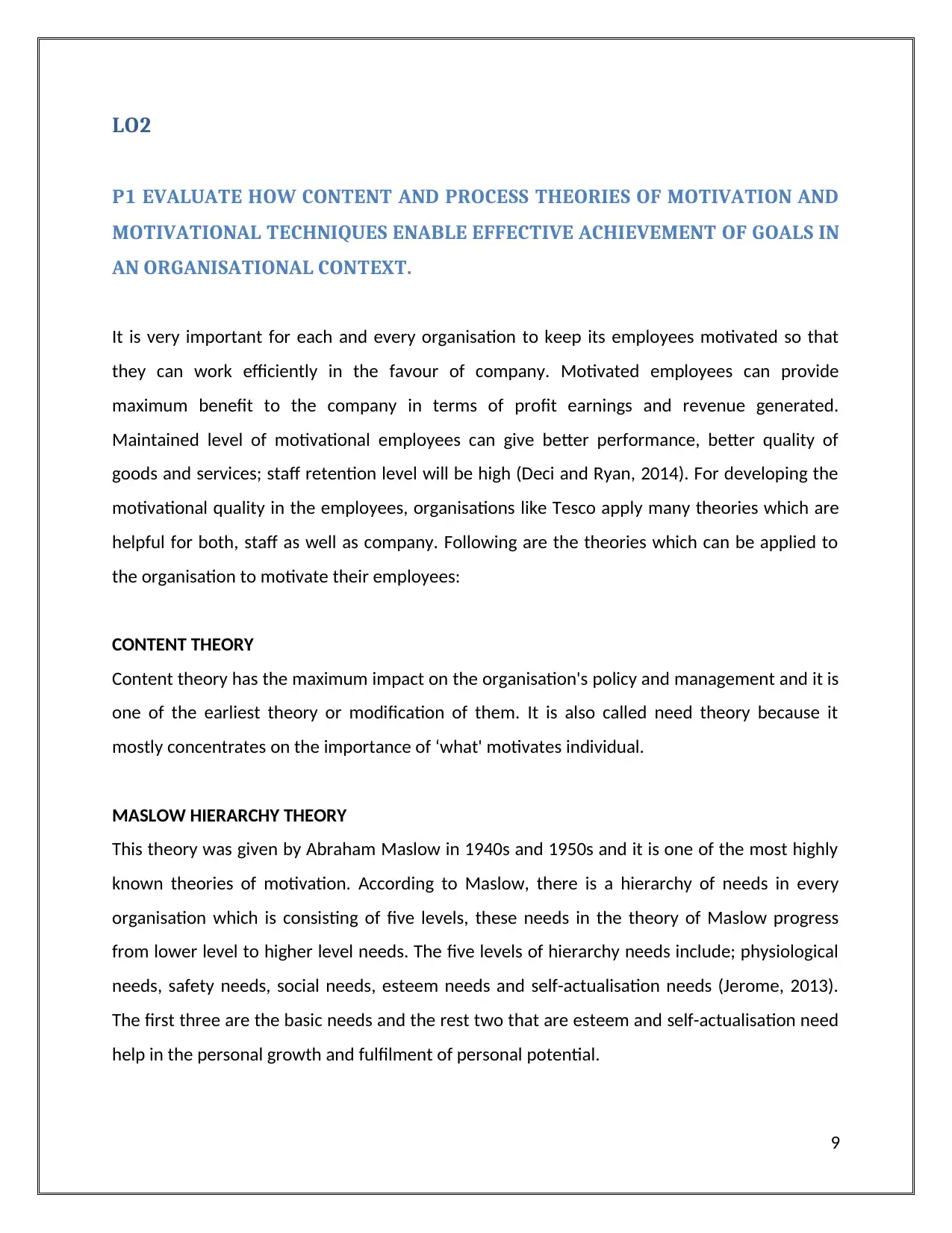
LO2
P1 EVALUATE HOW CONTENT AND PROCESS THEORIES OF MOTIVATION AND
MOTIVATIONAL TECHNIQUES ENABLE EFFECTIVE ACHIEVEMENT OF GOALS IN
AN ORGANISATIONAL CONTEXT.
It is very important for each and every organisation to keep its employees motivated so that
they can work efficiently in the favour of company. Motivated employees can provide
maximum benefit to the company in terms of profit earnings and revenue generated.
Maintained level of motivational employees can give better performance, better quality of
goods and services; staff retention level will be high (Deci and Ryan, 2014). For developing the
motivational quality in the employees, organisations like Tesco apply many theories which are
helpful for both, staff as well as company. Following are the theories which can be applied to
the organisation to motivate their employees:
CONTENT THEORY
Content theory has the maximum impact on the organisation's policy and management and it is
one of the earliest theory or modification of them. It is also called need theory because it
mostly concentrates on the importance of ‘what' motivates individual.
MASLOW HIERARCHY THEORY
This theory was given by Abraham Maslow in 1940s and 1950s and it is one of the most highly
known theories of motivation. According to Maslow, there is a hierarchy of needs in every
organisation which is consisting of five levels, these needs in the theory of Maslow progress
from lower level to higher level needs. The five levels of hierarchy needs include; physiological
needs, safety needs, social needs, esteem needs and self-actualisation needs (Jerome, 2013).
The first three are the basic needs and the rest two that are esteem and self-actualisation need
help in the personal growth and fulfilment of personal potential.
9
P1 EVALUATE HOW CONTENT AND PROCESS THEORIES OF MOTIVATION AND
MOTIVATIONAL TECHNIQUES ENABLE EFFECTIVE ACHIEVEMENT OF GOALS IN
AN ORGANISATIONAL CONTEXT.
It is very important for each and every organisation to keep its employees motivated so that
they can work efficiently in the favour of company. Motivated employees can provide
maximum benefit to the company in terms of profit earnings and revenue generated.
Maintained level of motivational employees can give better performance, better quality of
goods and services; staff retention level will be high (Deci and Ryan, 2014). For developing the
motivational quality in the employees, organisations like Tesco apply many theories which are
helpful for both, staff as well as company. Following are the theories which can be applied to
the organisation to motivate their employees:
CONTENT THEORY
Content theory has the maximum impact on the organisation's policy and management and it is
one of the earliest theory or modification of them. It is also called need theory because it
mostly concentrates on the importance of ‘what' motivates individual.
MASLOW HIERARCHY THEORY
This theory was given by Abraham Maslow in 1940s and 1950s and it is one of the most highly
known theories of motivation. According to Maslow, there is a hierarchy of needs in every
organisation which is consisting of five levels, these needs in the theory of Maslow progress
from lower level to higher level needs. The five levels of hierarchy needs include; physiological
needs, safety needs, social needs, esteem needs and self-actualisation needs (Jerome, 2013).
The first three are the basic needs and the rest two that are esteem and self-actualisation need
help in the personal growth and fulfilment of personal potential.
9
Paraphrase This Document
Need a fresh take? Get an instant paraphrase of this document with our AI Paraphraser
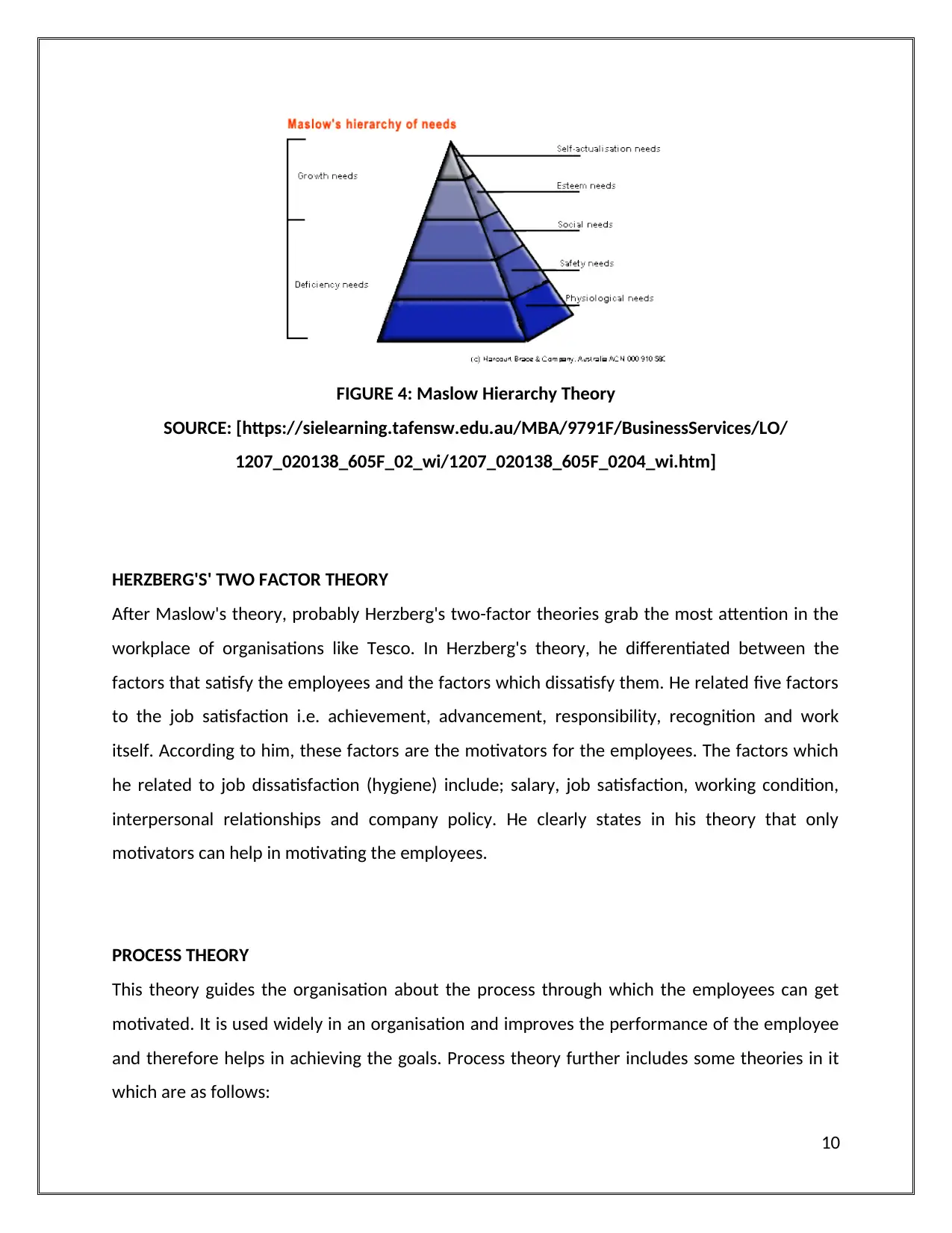
FIGURE 4: Maslow Hierarchy Theory
SOURCE: [https://sielearning.tafensw.edu.au/MBA/9791F/BusinessServices/LO/
1207_020138_605F_02_wi/1207_020138_605F_0204_wi.htm]
HERZBERG'S' TWO FACTOR THEORY
After Maslow's theory, probably Herzberg's two-factor theories grab the most attention in the
workplace of organisations like Tesco. In Herzberg's theory, he differentiated between the
factors that satisfy the employees and the factors which dissatisfy them. He related five factors
to the job satisfaction i.e. achievement, advancement, responsibility, recognition and work
itself. According to him, these factors are the motivators for the employees. The factors which
he related to job dissatisfaction (hygiene) include; salary, job satisfaction, working condition,
interpersonal relationships and company policy. He clearly states in his theory that only
motivators can help in motivating the employees.
PROCESS THEORY
This theory guides the organisation about the process through which the employees can get
motivated. It is used widely in an organisation and improves the performance of the employee
and therefore helps in achieving the goals. Process theory further includes some theories in it
which are as follows:
10
SOURCE: [https://sielearning.tafensw.edu.au/MBA/9791F/BusinessServices/LO/
1207_020138_605F_02_wi/1207_020138_605F_0204_wi.htm]
HERZBERG'S' TWO FACTOR THEORY
After Maslow's theory, probably Herzberg's two-factor theories grab the most attention in the
workplace of organisations like Tesco. In Herzberg's theory, he differentiated between the
factors that satisfy the employees and the factors which dissatisfy them. He related five factors
to the job satisfaction i.e. achievement, advancement, responsibility, recognition and work
itself. According to him, these factors are the motivators for the employees. The factors which
he related to job dissatisfaction (hygiene) include; salary, job satisfaction, working condition,
interpersonal relationships and company policy. He clearly states in his theory that only
motivators can help in motivating the employees.
PROCESS THEORY
This theory guides the organisation about the process through which the employees can get
motivated. It is used widely in an organisation and improves the performance of the employee
and therefore helps in achieving the goals. Process theory further includes some theories in it
which are as follows:
10
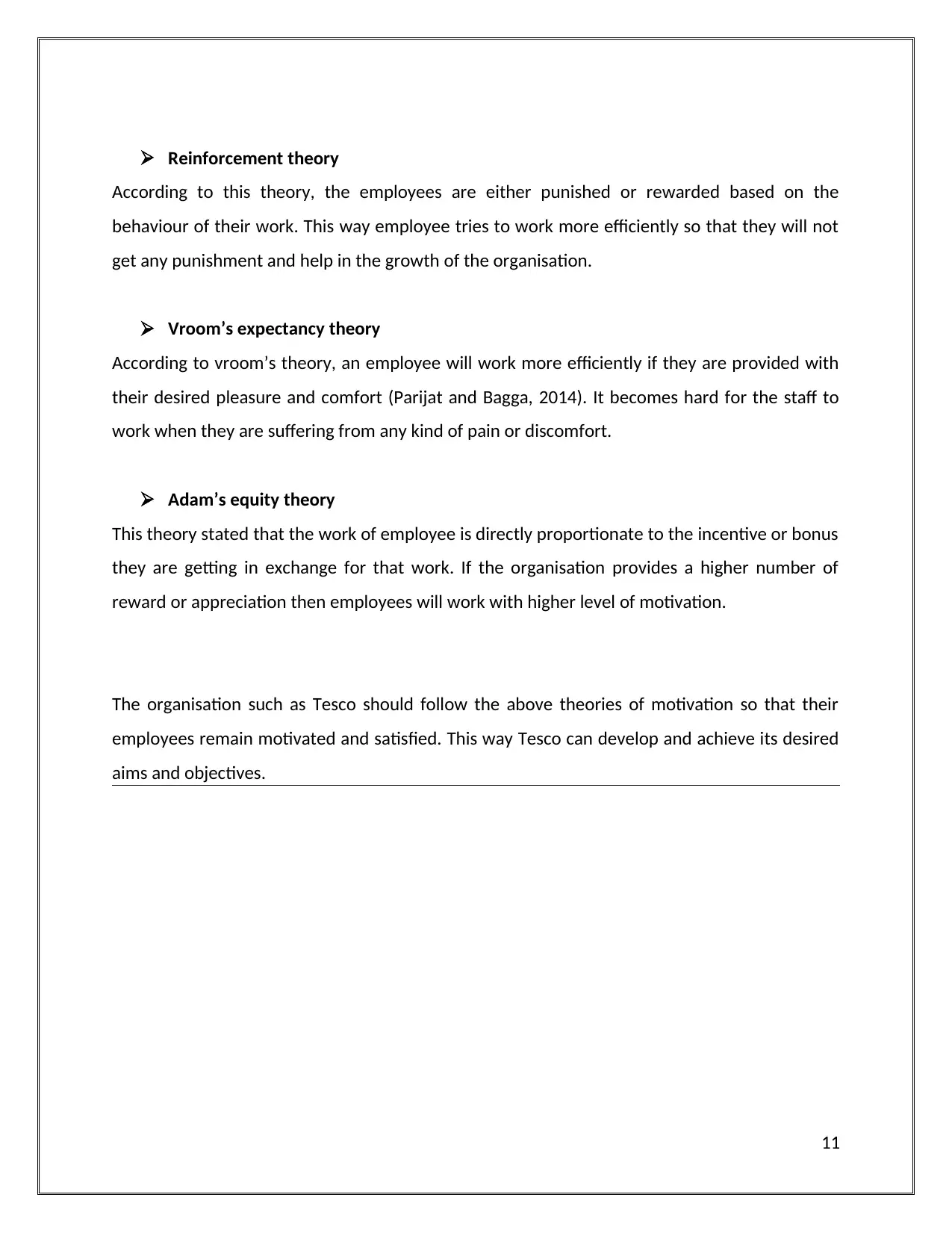
Reinforcement theory
According to this theory, the employees are either punished or rewarded based on the
behaviour of their work. This way employee tries to work more efficiently so that they will not
get any punishment and help in the growth of the organisation.
Vroom’s expectancy theory
According to vroom’s theory, an employee will work more efficiently if they are provided with
their desired pleasure and comfort (Parijat and Bagga, 2014). It becomes hard for the staff to
work when they are suffering from any kind of pain or discomfort.
Adam’s equity theory
This theory stated that the work of employee is directly proportionate to the incentive or bonus
they are getting in exchange for that work. If the organisation provides a higher number of
reward or appreciation then employees will work with higher level of motivation.
The organisation such as Tesco should follow the above theories of motivation so that their
employees remain motivated and satisfied. This way Tesco can develop and achieve its desired
aims and objectives.
11
According to this theory, the employees are either punished or rewarded based on the
behaviour of their work. This way employee tries to work more efficiently so that they will not
get any punishment and help in the growth of the organisation.
Vroom’s expectancy theory
According to vroom’s theory, an employee will work more efficiently if they are provided with
their desired pleasure and comfort (Parijat and Bagga, 2014). It becomes hard for the staff to
work when they are suffering from any kind of pain or discomfort.
Adam’s equity theory
This theory stated that the work of employee is directly proportionate to the incentive or bonus
they are getting in exchange for that work. If the organisation provides a higher number of
reward or appreciation then employees will work with higher level of motivation.
The organisation such as Tesco should follow the above theories of motivation so that their
employees remain motivated and satisfied. This way Tesco can develop and achieve its desired
aims and objectives.
11
⊘ This is a preview!⊘
Do you want full access?
Subscribe today to unlock all pages.

Trusted by 1+ million students worldwide
1 out of 26
Related Documents
Your All-in-One AI-Powered Toolkit for Academic Success.
+13062052269
info@desklib.com
Available 24*7 on WhatsApp / Email
![[object Object]](/_next/static/media/star-bottom.7253800d.svg)
Unlock your academic potential
Copyright © 2020–2025 A2Z Services. All Rights Reserved. Developed and managed by ZUCOL.


